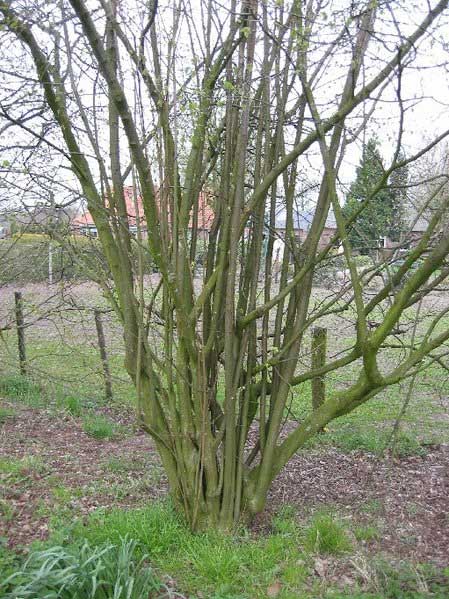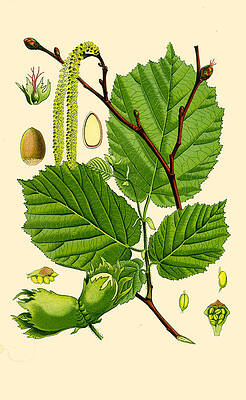Corylus avellana, Otto Wilhelm Thome
Classification System: APG IV
Superregnum: Eukaryota
Regnum: Plantae
Cladus: Angiosperms
Cladus: Eudicots
Cladus: Core eudicots
Cladus: Rosids
Cladus: Eurosids I
Ordo: Fagales
Familia: Betulaceae
Subfamilia: Coryloideae
Genus: Corylus
Species: Corylus avellana
Varietates: C. a. var. avellana – C. a. var. pontica
Name
Corylus avellana L., Sp. Pl. 2: 998 (1753).
Type locality: “Habitat in Europae sepibus”.
Type: “Avellana nux sylvestris” (Fuchs 1542: 397, 398) [icon] (lectotype, designated by Sell in Jarvis et al. 1993: 38). Superseding the lectotypification by Browicz in Rechinger, Fl. Iranica (1972: 97): LINN 1132.1.
Synonyms
Homotypic
Corylus avellana subsp. sylvestris Ehrh., Hannover. Mag. 18: 234 (1780), nom. inval.
Corylus avellana var. sylvestris Aiton, Hort. Kew. 3: 363 (1789), nom. inval.
Corylus sylvestris Salisb., Prodr. Stirp. Chap. Allerton: 392 (1796), nom. superfl.

Corylus avellana (*)
Distribution
Native distribution areas:
Corylus avellana
Continental: Europe
Regional: Northern Europe
Denmark, Finland, Føroyar, Great Britain, Ireland, Norway, Sweden.
Regional: Middle Europe
Austria, Belgium, Czechoslovakia, Germany, Hungary, Netherlands, Poland, Switzerland.
Regional: Southwestern Europe
Corse, France, Portugal, Sardegna, Spain.
Regional: Southeastern Europe
Albania, Bulgaria, Greece, Italy, Kriti (introduced), Romania, Sicilia, Yugoslavia.
Regional: Eastern Europe
Belarus, Baltic States, Krym, Central European Russia, East European Russia, North European Russia, South European Russia, Northwest European Russia, Ukraine.
Continental: Africa
Regional: Macaronesia
Azores (introduced).
Continental: Asia-Temperate
Regional: Caucasus
North Caucasus, Transcaucasus.
Regional: Western Asia
East Aegean Islands, Turkey.
References: Brummitt, R.K. 2001. TDWG – World Geographical Scheme for Recording Plant Distributions, 2nd Edition
References
Primary references
Linnaeus, C. 1753. Species Plantarum. Tomus II: 998. Reference page.
Additional references
Holstein, N., Tamer, S. el & Weigend, M. 2018. The nutty world of hazel names – a critical taxonomic checklist of the genus Corylus (Betulaceae). European Journal of Taxonomy 409: 1–45. Full text: DOI: 10.5852/ejt.2018.409 Reference page.
Jarvis, C.E., Barrie, F.R., Allan, D.M. & Reveal, J.L. 1993. A List of Linnaean Generic Names and their Types. Regnum Vegetabile 127: 1–100. Reference page.
Yaltırık, F. 1982. Corylus. Pp. 685–688 in Davis, P.H. (ed.), Flora of Turkey and the East Aegean Islands. Vol. 7 (Orobanchaceae to Rubiaceae). Edinburgh University Press, Edinburgh, 947 pp., ISBN 0-85224-396-0. Reference page.
Erdoğan, V. & Mehlenbacher, S.A. 2000. Phylogenetic relationships of Corylus species (Betulaceae) based on nuclear ribosomal DNA ITS region and chloroplast matK gene sequences. Systematic Botany 25(4): 727–737. DOI: 10.2307/2666730 Reference page.
Links
Govaerts, R. et al. 2019. Corylus avellana in World Checklist of Selected Plant Families. The Board of Trustees of the Royal Botanic Gardens, Kew. Published on the internet. Accessed: 2019 28 January. Reference page.
International Plant Names Index. 2019. Corylus avellana. Published online. Accessed: 28 January 2019.
Vernacular names
Afrikaans: Haselaar
العربية: بندق شائع
azərbaycanca: Adi fındıq
žemaitėška: Lazdīns
башҡортса: Сәтләүек ағасы
беларуская: Ляшчына звычайная
български: Обикновена леска
bosanski: Lijeska
català: Avellaner
Cebuano: Abelyana
kaszëbsczi: Zwëczajnô leszczëna
čeština: Líska obecná
Cymraeg: Collen
dansk: Almindelig Hassel
Deutsch: Gemeine Hasel
dolnoserbski: Wšedna lěšćina
English: Common Hazel
español: Avellano
eesti: Harilik sarapuu
euskara: Hurritz
suomi: Euroopanpähkinäpensas
français: Noisetier
furlan: Noglâr
Gàidhlig: Caomhan
galego: Abeleira
עברית: אגוז לוז
hrvatski: Obična lijeska
hornjoserbsce: Wšědna lěšćina
magyar: Európai mogyoró
Ido: Avelano
italiano: Nocciolo
日本語: セイヨウハシバミ
Lëtzebuergesch: Hieselter
lietuvių: Paprastasis lazdynas
latviešu: Lazda
македонски: Обична леска
norsk bokmål: Hassel
Nederlands: Hazelaar
norsk nynorsk: Hassel
occitan: Avelanièr comun
polski: Leszczyna pospolita
português: Avelã
Runa Simi: Iwrupa awillanu
română: Alun
русский: Лещина обыкновенная
sardu: Nitzola
srpskohrvatski / српскохрватски: Obična lijeska
slovenčina: Lieska obyčajná
shqip: Lajthia
српски / srpski: Леска
svenska: Hassel
Tagalog: Abelyana
Türkçe: Adi fındık
українська: Ліщина звичайна
West-Vlams: Hoazeloare
walon: Côrî
中文: 歐榛
Corylus avellana, the common hazel, is a species of hazel native to Europe and western Asia, from the British Isles south to Iberia, Italy, Greece, Turkey and Cyprus, north to central Scandinavia, and east to the central Ural Mountains, the Caucasus, and northwestern Iran.[2][3][4] It is an important component of the hedgerows that were the traditional field boundaries in lowland England. The wood was traditionally grown as coppice, the poles cut being used for wattle-and-daub building and agricultural fencing.
Common hazel is cultivated for its nuts. The name hazelnut applies to the nuts of any of the species of the genus Corylus, but in commercial settings a hazelnut is usually that of C. avellana. This hazelnut or cob nut, the kernel of the seed, is edible and used raw or roasted, or ground into a paste. The cob is round, compared with the longer filbert nut.
Description
Male catkins
Female flower
Common hazel is typically a shrub reaching 3–8 m tall, but can reach 15 m. The leaves are deciduous, rounded, 6–12 cm long and across, softly hairy on both surfaces, and with a double-serrate margin. The flowers are produced very early in spring, before the leaves, and are monoecious with single-sex wind-pollinated catkins. Male catkins are pale yellow and 5–12 cm long, while female flowers are very small and largely concealed in the buds with only the bright red 1–3 mm long styles visible. The fruit is a nut, produced in clusters of one to five together, each nut held in a short leafy involucre ("husk") which encloses about three quarters of the nut. The nut is roughly spherical to oval, 15–20 mm long and 12–20 mm broad (larger, up to 25 mm long, in some cultivated selections), yellow-brown with a pale scar at the base. The nut falls out of the involucre when ripe, about 7–8 months after pollination.[2][4][5]
It is readily distinguished from the closely related filbert (Corylus maxima) by the short involucre; in the filbert the nut is fully enclosed by a beak-like involucre longer than the nut.[2]
Taxonomy
The scientific name avellana derives from the town of Avella in Italy,[6] and was selected by Linnaeus from Leonhart Fuchs's De historia stirpium commentarii insignes (1542), where the species was described as "Avellana nux sylvestris" ("wild nut of Avella").[7] That name was taken in turn from Pliny the Elder's first century A.D. encyclopedia Naturalis Historia.[8]
Ecology
The leaves provide food for many animals, including Lepidoptera such as the case-bearer moth, Coleophora anatipennella. Caterpillars of the concealer moth, Alabonia geoffrella, have been found feeding inside dead common hazel twigs. See also List of Lepidoptera that feed on hazels.
The fruit are possibly even more important animal food, both for invertebrates adapted to circumvent the shell (usually by ovipositing in the female flowers, which also gives protection to the offspring) and for vertebrates which manage to crack them open (such as squirrels and corvids). Both are considered pests by hazelnut growers.
Cultivation and uses
Corylus avellana 'Contorta'
According to the New Sunset Western Garden Book, the European hazelnut is among the most widely grown hazelnut plants for commercial nut production.[9]
C. avellana 'Heterophylla'
Harry Lauder with his crooked walking stick (full-length portrait, New York, 1906)
This shrub is common in many European woodlands. It is an important component of the hedgerows that were the traditional field boundaries in lowland England. The wood was traditionally grown as coppice, the poles cut being used for wattle-and-daub building and agricultural fencing.[2]
The following ornamental cultivars have gained the Royal Horticultural Society's Award of Garden Merit:-
'Contorta'[10] (corkscrew hazel, Harry Lauder's walking stick)
'Red Majestic'[11]
Hazelnuts
Main article: Hazelnut
Hazelnuts
The hazelnut, also known as the cobnut, is the nut of the hazel. It is roughly spherical to oval in shape, about 15–25 mm long and 10–15 mm in diameter, with an outer fibrous husk surrounding a smooth shell. The nut falls out of the husk when ripe, about seven to eight months after pollination.
Hazelnuts are rich in protein and unsaturated fat. They also contain significant amounts of manganese, copper, vitamin E, thiamine, and magnesium.[12]
There are many cultivars of the hazel, including Barcelona, Butler, Casina, Clark Cosford, Daviana, Delle Langhe, England, Ennis, Fillbert, Halls Giant, Jemtegaard, Kent Cob, Lewis, Tokolyi, Tonda Gentile, Tonda di Giffoni, Tonda Romana, Wanliss Pride, and Willamette.[13] Some of these are grown for specific qualities of the nut including large nut size, and early and late fruiting cultivars, whereas other are grown as pollinators. The majority of commercial hazelnuts are propagated from root sprouts.[13] Some cultivars are of hybrid origin between common hazel and filbert.[5]
Common hazel is cultivated for its nuts in commercial orchards in Europe, Turkey, Iran and Caucasus. The name "hazelnut" applies to the nuts of any of the species of the genus Corylus. This hazelnut or cobnut, the kernel of the seed, is edible and used raw or roasted, or ground into a paste. The seed has a thin, dark brown skin which has a bitter flavour and is sometimes removed before cooking. The top producer of hazelnuts, by a large margin, is Turkey, specifically the Giresun Province. Turkish hazelnut production of 625,000 tonnes accounts for approximately 75% of worldwide production.[14]
References
Shaw, K.; Roy , S.; Wilson, B. (2014). "Corylus avellana". IUCN Red List of Threatened Species. 2014: e.T63521A3125935. doi:10.2305/IUCN.UK.2014-3.RLTS.T63521A3125935.en. Retrieved 19 November 2021.
Rushforth, K. (1999). Trees of Britain and Europe. Collins ISBN 0-00-220013-9.
Den Virtuella Floran: map
Trees for Life Hazel species profile Archived 2013-03-29 at the Wayback Machine
Flora of NW Europe: Corylus avellana Archived 2008-05-02 at the Wayback Machine
Mitchell, A. F. (1982). The Trees of Britain and Northern Europe. Collins ISBN 0-00-219037-0
Linnaeus, C. (1753). Species Plantarum p. 998.
"LacusCurtius • Pliny the Elder's Natural History — Book 23". penelope.uchicago.edu.
"Hazelnut Plants". Retrieved 2017-01-27.
"Corylus avellana 'Contorta'". RHS. Retrieved 27 September 2020.
"Corylus avellana 'Red Majestic'". RHS. Retrieved 27 September 2020.
SELF Nutrition data, Nuts, hazelnuts or filberts. Accessed 2014-08-22.
Huxley, A., ed. (1992). New RHS Dictionary of Gardening. Macmillan. ISBN 0-333-47494-5.
World Hazelnut Situation and Outlook, USDA 2004.
Retrieved from "http://en.wikipedia.org/"
All text is available under the terms of the GNU Free Documentation License


